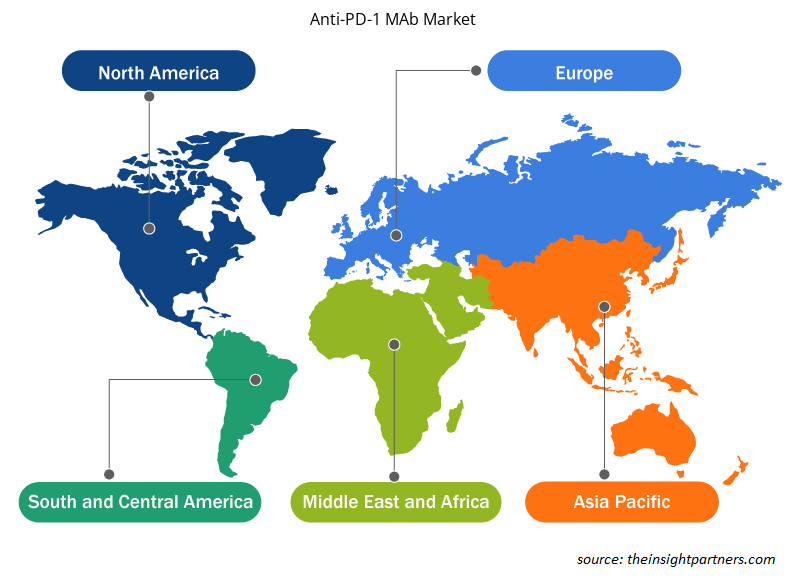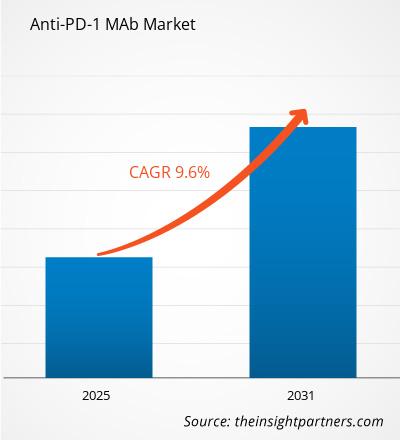The Anti-PD-1 MAb Market is expected to register a CAGR of 9.6% from 2024 to 2031, with a market size expanding from US$ XX million in 2024 to US$ XX Million by 2031.
The report is segmented By Product (40 mg, 10 mg, 200 mg and Others); Application (Melanoma Patients, Lung Cancer Patients , Lymphoma Patients, Others). The global analysis is further broken-down at regional level and major countries. The Report Offers the Value in USD for the above analysis and segments.
Purpose of the Report
The report Anti-PD-1 MAb Market by The Insight Partners aims to describe the present landscape and future growth, top driving factors, challenges, and opportunities. This will provide insights to various business stakeholders, such as:
- Technology Providers/Manufacturers: To understand the evolving market dynamics and know the potential growth opportunities, enabling them to make informed strategic decisions.
- Investors: To conduct a comprehensive trend analysis regarding the market growth rate, market financial projections, and opportunities that exist across the value chain.
- Regulatory bodies: To regulate policies and police activities in the market with the aim of minimizing abuse, preserving investor trust and confidence, and upholding the integrity and stability of the market.
Anti-PD-1 MAb Market Segmentation
Product
- 40 mg
- 10 mg
- 200 mg
Application
- Melanoma Patients
- Lung Cancer Patients
- Lymphoma Patients
Customize This Report To Suit Your Requirement
You will get customization on any report - free of charge - including parts of this report, or country-level analysis, Excel Data pack, as well as avail great offers and discounts for start-ups & universities
- Get Top Key Market Trends of this report.This FREE sample will include data analysis, ranging from market trends to estimates and forecasts.
Anti-PD-1 MAb Market Growth Drivers
- Rising Cancer cases: Increasing prevalence of cancer around the world, but notably in lung, melanoma, and others, is driving the market for immune checkpoint inhibitors, such as anti-PD-1 mAbs. Promising clinical outcomes drive the growth in the market and expand patient populations who are in need of advanced treatments.
- Advanced Technology in Immuno-Oncology: The clarification of the immune-checkpoint pathways and biomarkers improved the development of drugs, like anti-PD-1 therapies. Advanced technology will allow manufacturers and patients to reach treatment modalities that target defined requirements, making the market for such drugs appealing to manufacturers as well as patients.
- Regulatory Approvals and Expansions: The FDA and EMA have enhanced approval timelines for cancer therapies. Anti-PD-1 mAbs have been approved through FDA's fast track for several types of cancers that created large markets for these drugs. As the number of indications approved is rising, this market is expanding at a very high rate.
Anti-PD-1 MAb Market Future Trends
- Combination Therapies: The latest trend is combining anti-PD-1 mAbs with other treatment modalities, including chemotherapy and targeted therapies, or other immunotherapies. Early clinical data indicate and growing evidence for enhanced efficacy of the anti-PD-1 therapies and for their broadening application in treating many different types of cancers, even those refractory to single-agent therapy.Biosimilars Development: The emergence of biosimilars in the anti-PD-1 class is thereby very much supporting lower cost of treatment and increasing market access for these drugs. Affordable substitutes are now quickly coming off patent as patents continue to expire for leading anti-PD-1 mAbs, including pembrolizumab, marketed as Keytruda.Personalized Medicine: The rising use of biomarker-driven approaches to direct selection for those patients who are most likely to benefit from anti-PD-1 drugs is reshaping treatment paradigms. Predictive biomarkers help stratified treatments that receive better outcomes and avoid unnecessary costs and promote a more precise and efficient health-care system support to position the patient with proper alinement without the much discomfort during long periods of treatment time. Innovations that have become standards include the reclining adjustable position, padded arm rests, and lumbar support. All these contribute to a better patient experience and satisfaction.
- Integration of Smart Technology: One of the current trends is the integration of smart technology into dialysis chairs. Advanced monitoring systems built directly into the chair, along with facilities for direct wireless connectivity and easy interfaces, bring several benefits to healthcare providers: the real-time monitoring of the patient's vital signs and treatment process. This technological advance not only facilitates the dialysis process but also provides better safety and individualized care for patients undergoing dialysis.
- Sustainability and Eco-Friendly Materials: Sustainability is the tendency of the dialysis chairs market, which has seen more of eco-friendly materials and processes come into production for the same. Concerns about sustainable practices in health facilities are driving demand for recyclable and non-toxic material usage in chairs and other types of furniture. Beyond being compliant with regulatory requirements, such chairs attract health-conscious buyers involved in a broader trend of environmental stewardship in health care.
Anti-PD-1 MAb Market Opportunities
- Expanding Indications: Beyond the settings of efficacy in melanoma and non-small cell lung cancer, there is a great potential opportunity to expand the indications of anti-PD-1 mAbs. The huge scope for growth by ongoing clinical trials into gastric, esophageal, and liver cancer offers promise.
- Growth in Emerging Market: Anti-PD-1 mAbs have great growth potential in emerging markets. It has huge growth potential here with the development of the healthcare market, upgrading the availability of diagnostic infrastructure, and a growing burden of cancer within Asian and Latin American regions.
- Enhanced Patient Access Programs: Since cost remains one of the biggest obstacles to access for most patients, companies can create a patient assistance program, tiered pricing, or pay-for-performance models. These strategies improve market penetration and ensure more access to life-saving therapies for the patients, especially in resource-poor settings.
Anti-PD-1 MAb Market Regional Insights
The regional trends and factors influencing the Anti-PD-1 MAb Market throughout the forecast period have been thoroughly explained by the analysts at Insight Partners. This section also discusses Anti-PD-1 MAb Market segments and geography across North America, Europe, Asia Pacific, Middle East and Africa, and South and Central America.

- Get the Regional Specific Data for Anti-PD-1 MAb Market
Anti-PD-1 MAb Market Report Scope
| Report Attribute | Details |
|---|---|
| Market size in 2024 | US$ XX million |
| Market Size by 2031 | US$ XX Million |
| Global CAGR (2025 - 2031) | 9.6% |
| Historical Data | 2021-2023 |
| Forecast period | 2025-2031 |
| Segments Covered |
By Product
|
| Regions and Countries Covered | North America
|
| Market leaders and key company profiles |
Anti-PD-1 MAb Market Players Density: Understanding Its Impact on Business Dynamics
The Anti-PD-1 MAb Market market is growing rapidly, driven by increasing end-user demand due to factors such as evolving consumer preferences, technological advancements, and greater awareness of the product's benefits. As demand rises, businesses are expanding their offerings, innovating to meet consumer needs, and capitalizing on emerging trends, which further fuels market growth.
Market players density refers to the distribution of firms or companies operating within a particular market or industry. It indicates how many competitors (market players) are present in a given market space relative to its size or total market value.
Major Companies operating in the Anti-PD-1 MAb Market are:
- Merck,
- Junshi Pharma
- Cohereus Biosciences
- Aditya Pharma
- Genetech
Disclaimer: The companies listed above are not ranked in any particular order.

- Get the Anti-PD-1 MAb Market top key players overview
Key Selling Points
- Comprehensive Coverage: The report comprehensively covers the analysis of products, services, types, and end users of the Anti-PD-1 MAb Market, providing a holistic landscape.
- Expert Analysis: The report is compiled based on the in-depth understanding of industry experts and analysts.
- Up-to-date Information: The report assures business relevance due to its coverage of recent information and data trends.
- Customization Options: This report can be customized to cater to specific client requirements and suit the business strategies aptly.
The research report on the Anti-PD-1 MAb Market can, therefore, help spearhead the trail of decoding and understanding the industry scenario and growth prospects. Although there can be a few valid concerns, the overall benefits of this report tend to outweigh the disadvantages.
- Historical Analysis (2 Years), Base Year, Forecast (7 Years) with CAGR
- PEST and SWOT Analysis
- Market Size Value / Volume - Global, Regional, Country
- Industry and Competitive Landscape
- Excel Dataset
- Digital Pathology Market
- Workwear Market
- Identity Verification Market
- Adaptive Traffic Control System Market
- Europe Industrial Chillers Market
- Clear Aligners Market
- Investor ESG Software Market
- Transdermal Drug Delivery System Market
- Rare Neurological Disease Treatment Market
- Genetic Testing Services Market

Report Coverage
Revenue forecast, Company Analysis, Industry landscape, Growth factors, and Trends

Segment Covered
This text is related
to segments covered.

Regional Scope
North America, Europe, Asia Pacific, Middle East & Africa, South & Central America

Country Scope
This text is related
to country scope.
Frequently Asked Questions
Rising cancer cases is the major factors boosting the Anti-PD1 Mab Market growth
The market is expected to grow at a CAGR of 9.6%
Asia Pacific is estimated to grow at the highest CAGR over the forecast year (2023 - 2031)
North America region accounts for highest revenue share Anti-PD1 Mab Market
The final report will duly include market size and projection estimates for all the segments from 2021 to 2031, along with a revenue share and compound annual growth rate (%) for the regional
/
country-wise market wherein 2021-2022 are the historic years, 2023 is considered to be the base year, and the forecast will be provided till 2031, along with CAGR (%)
Merck, Junshi Pharma,Cohereus Biosciences, Aditya Pharma, Genetech,Bristols Meyers Squibb,Top Alliance
Trends and growth analysis reports related to Life Sciences : READ MORE..
1.Merck
2.Junshi Pharma
3.Coherus BioSciences
4.Bristol Myers Squibb
5.TopAlliance Biosciences Co., Ltd.
6.Selleck Chemicals
7.Aditya Pharma
8.Beijing Beigene
9.Genentech
10.Innovent Biologics Inc




 Get Free Sample For
Get Free Sample For